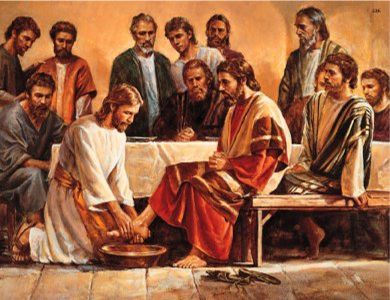A meditation on Lent from The Liturgical
Year by Abbot Dom Guéranger,
O.S.B.
After having, on this day, washed the feet of His
disciples, Jesus said to them: 'Know ye what I have done to you? You call Me
Master and Lord: and You say well, for so I am. If then I, being your Lord and
Master, have washed your feet; you, also, ought to wash one another's feet. For
I have given you an example, that as I have done to you, so you do also.'[1]
Although the meaning of these words is that, after the example of our divine
Master, we should practice works of fraternal charity towards our neighbour, yet
the literal imitation of this our Saviour's act has always been observed in the
Church.
At the commencement, it was almost a daily practice. St. Paul, when mentioning
the qualities which should adorn the Christian widow, includes that of washing
the feet of the saints,[2] that is, of the faithful. We find this act of humble
charity practised in the ages of persecution, and even later. The Acts of the
saints of the first six centuries, and the homilies and writings of the holy
fathers, are filled with allusions to it. Afterwards, charity grew cold, and
this particular way of
exercising it was confined, almost exclusively, to
monasteries. Still, from time to time it was practiced elsewhere. We
occasionally find kings and queens setting this example of humility. The holy
king Robert of France, and, later, Saint Louis, used frequently to wash the feet
of the poor. The holy queen St. Margaret of Scotland, and Saint Elizabeth of
Hungary, did the same. The Church, with that spirit which makes her treasure up
every recommendation of her divine Lord, has introduced this act of humility
into her liturgy, and it is today that she puts the great lesson before her
children. In every church of any importance, the prelate, or superior, honours
our Saviour's condescension, by the ceremony called the washing of the feet.
The bishops throughout the world follow the example set them by the sovereign
Pontiff, who performs this ceremony in the Vatican. Yea, there are still to be
found kings and queens who, on this day, wash the feet of the poor, and give
them abundant alms.
The twelve apostles are represented by the twelve poor who, according to the
most general practice, are chosen for this ceremony. The Pope, however, washes
the feet of thirteen priests of as many different countries; and this is the
reason of the ceremonial requiring this number for cathedral churches. But, why
thirteen? Some have interpreted it thus: that it represented the full number of
the apostolic college, which is thirteen; for St. Mathias was elected in Judas's
place, and our Lord Himself, after His Ascension, called St. Paul to be an
apostle. Other authors, however, and among them the learned Pope Benedict
XIV,[3] assert that the reason of this number being chosen was the miracle
related in the life of St. Gregory the Great. This holy Pope used, every day, to
wash the feet of twelve poor men, whom he afterwards invited to his own table.
One day, a thirteenth was present: it was an angel, whom God had sent, that He
might thereby testify how dear to Him was the charity of His servant.
The ceremony of the washing of the feet is also called the Mandatum, from
the first word of the first antiphon. After the deacon has chanted the Gospel of
the Mass of Maundy Thursday, the celebrant takes off the cope, girds himself
with a towel, and, kneeling down, begins to wash the feet of those who have been
chosen. He kisses the right foot of each one after having washed it.
ENDNOTES
1. 1 St. John xiii. 12-15.
2 1 Tim. v. 10.
3 De Festis D. N.J. C. lib. I. cap. vi. no. 57

Thank you Father for your very informative meditation.
ReplyDeleteGod Bless You this Easter season.